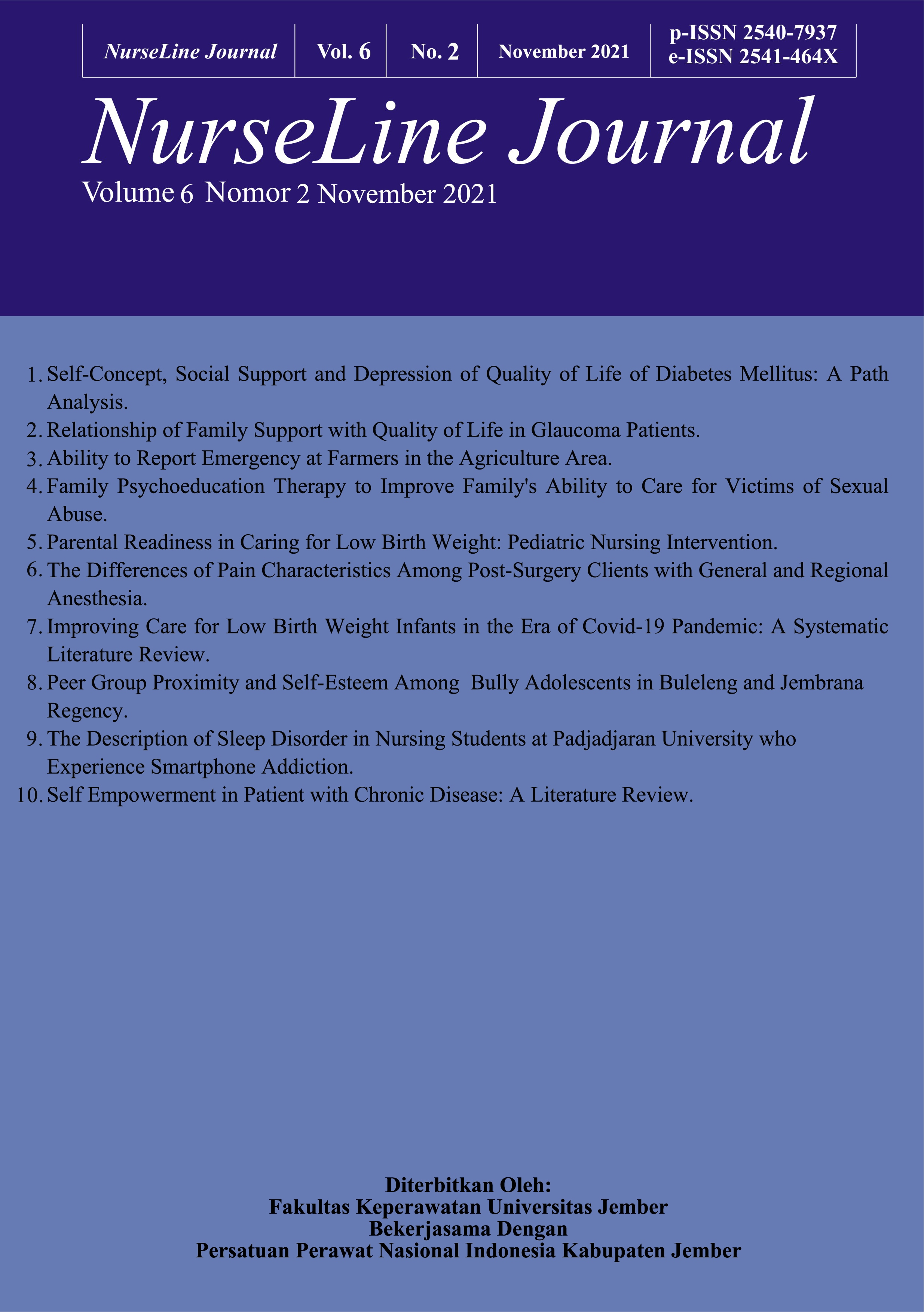Peer Group Proximity and Self-Esteem Among Bully Adolescents in Buleleng and Jembrana Regency
DOI:
https://doi.org/10.19184/nlj.v6i2.19397Keywords:
self-esteeem, peer group closeness, bully behaviorAbstract
Background: Bullying can be a mental problem for adolescents that has an impact on psychological disorders to suicide, not only for the victim but also for the bully. Handling the impact of bullying so far has only focused on victims, attention should also be directed to bully, because bully is the main actor in the occurrence of bullying. Purpose: To analyze the relationship between self-esteem and peer group proximity with bully behavior among adolescents in Buleleng and Jembrana. Methods: Quantitative research with a cross-sectional approach, samples were taken from junior high school students in Buleleng and Jembrana Districts. The measuring instrument used a questionnaire to screen adolescents who tend to be bully, a self-esteem questionnaire, a peer group closeness questionnaire and a bully behavior questionnaire. The number of samples in this study were 78 people taken by stratified random sampling technique. Univariate analysis was carried out to determine the sociodemographic characteristics of the respondents, then the analysis of the relationship between self-esteem and bully behavior used Rank Spearman as well as the relationship between peer group proximity and bully behavior. Results: Self-esteem has a significant relationship with p <0.05, r = -0.867 with teenage bullying. Peer group closeness has a significant relationship with p <0.05, r = -0.556 with bully behavior. Conclusion: Self-esteem and peer group proximity are significantly associated with bullying behavior. The higher the level of self-esteem and peer group closeness, the lower the bullying's behavior.
Downloads
References
CDC. (2011). Measuring Bullying, Victimization, Perpetration, and Bystander, Experiences: A Compendium of Assessment Tools. Giorgia National Center for Injury Prevention and Control.
Copeland, William E, Wolke, Dieter, Angold, Adrian, & Costello, E Jane. (2013). Adult psychiatric outcomes of bullying and being bullied by peers in childhood and adolescence. JAMA psychiatry, 70(4), 419-426.
Fanti, Kostas A, & Henrich, Christopher C. (2015). Effects of self-esteem and narcissism on bullying and victimization during early adolescence. The Journal of Early Adolescence, 35(1), 5-29.
Gullone, Eleonora, & Robinson, Kym. (2005). The inventory of parent and peer attachment—Revised (IPPAâ€R) for children: a psychometric investigation. Clinical Psychology & Psychotherapy, 12(1), 67-79.
Hastuti, Dwi, & Puspitawati, Herien. (2015). Gaya Pengasuhan Ibu Dan Perilaku Bullying Remaja Pada Keluarga Bercerai Di Kota Bogor. Bogor Agricultural University (IPB).
Herman, Hermalinda, Nurshal, Deswita, & Oktarina, Elvi. (2018). Hubungan karakteristik remaja dengan perilaku bullying pada siswa SMP Di Kota Padang. Jurnal Keperawatan Soedirman, 12(1), 1-11.
Hesapçioğlu, Selma Tural, Meraler, Habibe Yeşilova, & Ercan, Filiz. (2018). Bullying in schools and its relation with depressive symptoms, self-esteem, and suicidal ideation in adolescents. Anadolu Psikiyatri Dergisi, 19(2), 210-216.
Hidajat, Monica, Adam, Angry Ronald, Danaparamita, Muhammad, & Suhendrik, Suhendrik. (2015). Dampak Media Sosial dalam Cyber Bullying. ComTech: Computer, Mathematics and Engineering Applications, 6(1), 72-81.
Khamis, Vivian. (2015). Bullying among school-age children in the greater Beirut area: Risk and protective factors. Child abuse & neglect, 39, 137-146.
Lipnevich, A.A., Preckel, F., & Roberts, R.D. (2016). Psychosocial Skills and School Systems in the 21st Century: Theory, Research, and Practice: Springer International Publishing.
Mulyati, Mulyati. (2015). Hubungan tingkat harga diri dengan perilaku bullying pada anak usia sekolah kelas iv dan v di SD Negeri Bumijo Yogyakarta. STIKES'Aisyiyah Yogyakarta.
Murphy, Tia Panfile, Laible, Deborah, & Augustine, Mairin. (2017). The influences of parent and peer attachment on bullying. Journal of child and family studies, 26(5), 1388-1397.
Nilan, Pam, Burgess, Haley, Hobbs, Mitchell, Threadgold, Steven, & Alexander, Wendy. (2015). Youth, social media, and cyberbullying among Australian youth:“Sick friendsâ€. Social Media+ Society, 1(2), 2056305115604848.
Olweus, Dan, & Limber, Susan P. (2010). Bullying in school: Evaluation and dissemination of the Olweus Bullying Prevention Program. American Journal of Orthopsychiatry, 80(1), 124-134.
Sandri, Ritna. (2015). Perilaku bullying pada remaja panti asuhan ditinjau dari kelekatan dengan teman sebaya dan harga diri. Jurnal Psikologi Tabularasa, 10(1).
Sterzing, Paul R, Auslander, Wendy F, Ratliff, G Allen, Gerke, Donald R, Edmond, Tonya, & Jonson-Reid, Melissa. (2020). Exploring bullying perpetration and victimization among adolescent girls in the child welfare system: Bully-only, victim-only, bully-victim, and noninvolved roles. Journal of interpersonal violence, 35(5-6), 1311-1333.
Tolsma, Jochem, van Deurzen, Ioana, Stark, Tobias H., & Veenstra, René. (2013). Who is bullying whom in ethnically diverse primary schools? Exploring links between bullying, ethnicity, and ethnic diversity in Dutch primary schools. Social Networks, 35(1), 51-61. doi: https://doi.org/10.1016/j.socnet.2012.12.002
Usman, Irvan. (2013). Kepribadian, komunikasi, kelompok teman sebaya, iklim sekolah dan perilaku bullying. HUMANITAS (Jurnal Psikologi Indonesia), 10(1), 49-60.
WHO. (2017). Global strategy for women's, children's and adolescents' health (2016-2030). Organization, 2016(9).
Widiharto, Chr Argo. (2011). Perilaku bullying, harga diri dan pemahaman moral anak. Metamorfosis, 5(19).
Yusuf, & Fahrudin, Adi. (2012). Perilaku bullying: asesmen multidimensi dan intervensi sosial. Jurnal Psikologi Undip, 11(2), 10.
Zakiyah, Ela Zain, Humaedi, Sahadi, & Santoso, Meilanny Budiarti. (2017). Faktor yang mempengaruhi remaja dalam melakukan bullying. Prosiding Penelitian dan Pengabdian kepada Masyarakat, 4(2).
Zhao, Ruo Bing, & Chang, Yuan-Cheng. (2019). Students' Family Support, Peer Relationships, and Learning Motivation and Teachers Fairness Have an Influence on the Victims of Bullying in Middle School of Hong Kong. International Journal of Educational Methodology, 5(1), 97-107.








